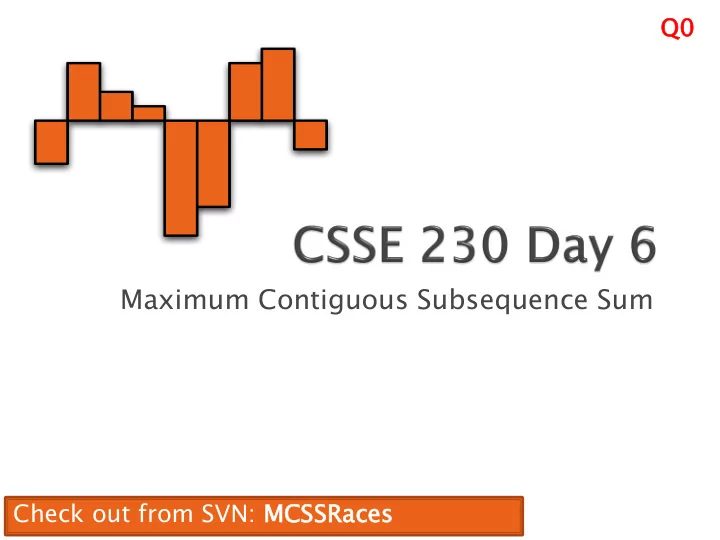

Q0 Q0 Maximum Contiguous Subsequence Sum Check out from SVN: MCS CSSRac Races es
Good c d comme mments ts: ◦ Javadoc comments for public fields and methods. ◦ Explanations of anything else that is not obvious. Good v d varia iable ble a and method od name mes: ◦ Eclipse has name completion (ALT /), so the “typing cost” of using long names is small Use loc local l vari riables and s d sta tati tic me meth thods (instead of fields and non-static methods) where appropriate ◦ “where appropriate” includes any place where you can’t explicitly justify creating instance fields No s No supe per-long lin lines of of code ode No s No supe per-lon long m g meth thods ods: use top down design Consi sist stent indenta tation tion (ctrl-shift f) Bla lank lin lines between methods, space ace after punctuation
Q1 Q1 In {-2, 11, 1, -4, 13 13, -5, 2}, MCSS is S 2,4 = ? In {1, -3, 4, -2, -1, 6}, what is MCSS?
We can do even better than this!
A linear algorithm. {-3, 4, 2, 1, -8, -6, 4, 5, -2}
Q2 Q2 Consider {-3, 4, 2, 1, -8, -6, 4, 5, -2} Any subsequences you can safely ignore? ◦ Discuss with another student (2 minutes)
Q3 Q3 We noted that a max-sum sequence A i,j cannot begin with a negative number. Generalizing this, it cannot begin with a prefix ( A i,k with k<j) whose sum is negative. ◦ Proo oof: If S i, i,k is n negative, e, t then en S S k+1, j > > S i,j 1,j ,j , so A i, so i,j wou ould not ot be be a se sequ quence th that pr produces th the maximum um s sum.
All contiguous subsequences that border the maximum contiguous subsequence must have negative (or zero) sums. ◦ Proo oof: If one of them had a positive sum, we could simply append (or “prepend”) it to get a sum that is larger than the maximum. Impossible!
Q4 Q4-5
Q6 Q6 If we find that S i,j is negative, we can skip all sums that begin with any of A i , A i+1 , …, A j . There is no new MCS that starts anywhere between A i and A j . So we can “skip i ahead” to be j+1. Observa vati tion n 3 a again:
Q7 Q7 S i,j is negative. So, skip ahead per Observation 3 Running time is is Θ (?) How do we know?
From SVN, checkout MCSSRaces Study code in MCSS.main() For each algorithm, how large a sequence can you process on your machine in less than 1 second?
Q9-10 Q9 10 The first algorithm we think of may be a lot worse than the best one for a problem Sometimes we need clever ideas to improve it Showing that the faster code is correct can require some serious thinking Programming is more about careful consideration than fast typing!
A cheezy, helpful video http://www.youtube.com/watch?v=rG_U12uqRhE&feature=plcp
Also known as Deterministic Finite Automata
A finite set of states es, ◦ One is the sta tart sta tate te ◦ Some are final nal, a.k.a acce cepting ing,states A finite alphabet et (input symbols) A tra ransi nsitio ion f func unction How it works: ◦ Begin in start state ◦ Read an input symbol ◦ Go to the next state according to transition function ◦ More input? Yes, then repeat No, then if in accept state, return true, else return false.
Draw a FSM to determine whether a lowercase sequence of characters contains each of the 5 regular vowels once in order ◦ Example: facetious In some versions of FSMs, each transition generates output.
A C B D
Indicate the Start State and final (accepting) states FSM1: ◦ Input alphabet {0, 1} ◦ Accepts (ends in an accepting state) all input strings that do NOT contain 010 as a substring FSM2: (only if you get the first one done quickly) ◦ Input alphabet {0, 1} ◦ Accepts (ends in an accepting state) all input strings that are x bin binary ry x binary bin ry binary representations 0 0 7 111 of numbers that are 1 1 8 1000 divisible by 3 2 10 9 1001 Hints: Use 4 states, a start state plus 3 11 10 1010 1 state each for x%3==0, x%3==1, and x%3==2. 4 100 11 1011 What does the arrival of a 0 do to 5 101 12 1100 the current value? (doubles it) What 6 110 13 1101 about a 1?
A pair programming assignment. Due (along with Hardy, Part 2) on Class Day 10.
Input: legal Java source code Output: colorized HTML ◦ Keywords in blue, strings in red, comments in green, everything else in black ◦ Layout just like original Java input file We can use an FSM for this!
FSM representations
Q8-10 Diagra rams ms on n the e white teboa board 2-Dimensional array: ◦ Rows indexed by state, Columns by input character. ◦ Each array entry is a pair object (as in DS Section 3.7): [next state, what to print] Monolithic controller with nested switch statements The first choice may be more efficient and have shorter code The second choice is probably easier to write and modify ◦ Can be made more modular by having a method for each state
Recommend
More recommend